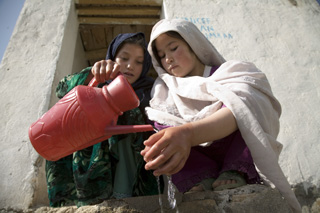Global Handwashing Day on 15 October 2010 aims to raise awareness about the health benefits of handwashing with soap.
The challenge is to make handwashing with soap an automatic behaviour performed in homes, schools, and communities worldwide. In developing countries this is literally a life and death issue.
Improving water, sanitation and hygiene (WASH) will help to achieve most the Millennium Development Goals (MDGs); for example, basic sanitation, improved hygiene practices, safe drinking water sources and more water for washing reduces infant and child illness and death, and helps to achieve MDGs 4 and 5.
Diarrhoeal diseases are estimated to be the cause of 1.6 million deaths per year, of which around 90 per cent are children. Diarrhoeal diseases are often passed through untreated water or from person to person due to poor hygiene.
Research in 2009, conducted by International Initiative Impact Evaluation (3ie), indicates that the three most effective interventions to reduce diarrhoea morbidity in children under five are:
- hand washing with soap
- improved sanitation
- water treatment.
According to WHO and UNICEF globally:
- more than 2.6 billion people do not use basic sanitation facilities
- almost half the population of developing regions do not have adequate access to basic sanitation facilities
- at least a billion people continue to defecate in the open, for example, in fields or rivers
- 880 million people still do not have access to safe drinking water.
In addition to diarrhoea, the spread of skin and eye infections, such as scabies and trachoma, is exaggerated by poor hygiene practices and a lack of access to safe water for bathing and washing clothes. Trachoma, for example, is the key cause of preventable blindness worldwide. An estimated 6 million people in the world are blind and more than 150 million people require medical treatment due to trachoma.
Millennium Development Goal 7 sets a target to halve the proportion of people without access to safe drinking water and basic sanitation, by 2015. The Australian Government is committed to this target and is working to give more people access to clean water and adequate sanitation by:
- improving water supply and sanitation infrastructure in poor urban and rural areas - in Africa 8,473 households–approximately 51,000 people–have access to clean water and sanitation following the installation of safe water points in communities in Zimbabwe, Kenya and Malawi
- promoting better hygiene to maximise the benefits of improved water and sanitation services - through the Civil Society WASH Fund, Australian is funding Plan International Australia, in Indonesia, to increase awareness of better hygiene practices through handwashing which will help to improve health outcomes
- supporting partnerships to strengthen water planning and management, enhance access to safe drinking water, increase water conservation and storage capacity– the Water Financing Partnership Facility (WFPF)–partly funded by Australia and run by the Asian Development Bank–aims to deliver substantial investment, reform, and capacity development in three key areas–rural water services, urban water services, and river basin water management
- enhancing sanitation and waste management to prevent the contamination of water - in Vietnam, in the last three years Australia, in cooperation with other donors, has helped increase access to clean water and sanitation in nine targeted provinces. Over this period 173,916 households received access to sanitation.
Global Handwashing Day Quiz
Which MDG covers water and sanitation?
How many people in the world do not use improved sanitation (such as a toilet or a covered pit latrine)?
(a) 1.2 billion (b) 1.8 billion (c) 2.6 billion
What proportion of these people live in Asia?
How many people use unimproved sources for drinking-water?
(a) 550 million (b) 880 million (c) 990 million
What percentage of people in Uganda have soap in the house?
Diarrhoeal diseases are estimated to cause around 1.6 million deaths per year - one of the largest killers of children under 5. What proportion of this is caused by drinking unsafe water and inadequate sanitation and hygiene?
(a) 33 per cent (b) 55 per cent (c) 88 per cent
How many school days are lost per year from water related diseases?
(a) 225 million (b) 350 million (c) 443 million
What proportion of intestinal worms can be prevented by handwashing with soap?
How many more girls are likely to attend school if adequate sanitation facilities are available?
(a) 5% (b) 11% (c) 20%
There are 545 million connected mobile phones India. How many people have access to safe and hygienic sanitation?
(a) 366 million (b) 466 million (c) 566 million

